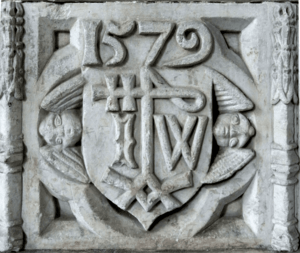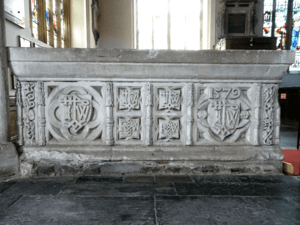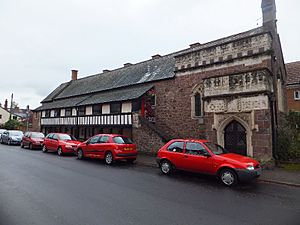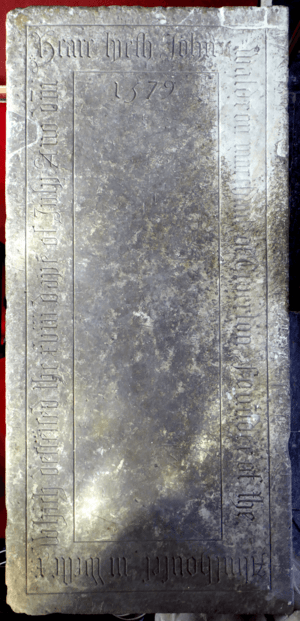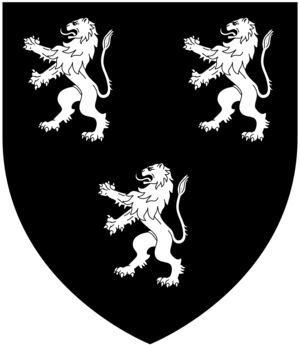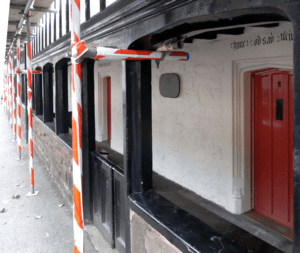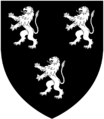John Waldron (died 1579) facts for kids
John Waldron (died 18 July 1579) was a very rich merchant from Tiverton, England. He is famous for building and supporting "Waldron's Almshouses" and a chapel. These buildings are still standing today and are important historical sites.
His tomb is in St Peter's Church in Tiverton. It has detailed carvings in an old style called Gothic. The tomb shows his special "merchant's mark," which was like a personal logo for traders back then. Sometimes, people confuse his name with the "Walrond" family, but his name is clearly spelled "Waldron" on his tomb.
Contents
John Waldron's Family Life
John Waldron married Richord Prowse (who died in 1604). Her father, John Prowse, was a cloth merchant and a respected gentleman from Tiverton. Richord's brother, Robert Prowse, was also a merchant and even became the Mayor of Barnstaple in 1588.
The Prowse family was a very old and important family in Devon. They were related to the Earls of Devon, who used to own Tiverton Castle. After John Waldron died, Richord married Roger Gifford in 1580. Roger Gifford was also from an old family and had bought Tiverton Castle. Richord was buried in Tiverton in 1604.
Helping the Community
John Waldron was known for his kindness and for helping people in need. He was involved in several important charitable projects during his lifetime.
Early Charity Work
One of John Waldron's first charity projects was helping with "Tyrrell's Gift To The Poor." This was a large sum of money (£200) left by Walter Tyrrell in his will in 1568. Waldron was one of the people in charge of making sure this money was used to help poor people in Tiverton.
In 1575, Waldron set up a special fund. He made sure that £10 and 13 shillings would be paid every year from his lands to help the poor people of Tiverton. This money was given to the church guardians and other trusted people to manage.
Waldron's Almshouses
John Waldron's most famous act of charity was building the almshouses. In 1577, he set aside £24 each year from his lands to support these houses. The money was given to the churchwardens and other trustees.
The almshouses were built for poor people to live in. People could live there for life, as long as they behaved well and didn't commit any crimes. The extra money was used to pay the trustees for their work.
The Almshouse Building
The almshouses were built on the edge of Tiverton, near a stream called "Wellbrook." Over time, the town grew, and now "Wellbrook Street" runs right past the buildings. In the 20th century, more modern homes for charity were built behind the original almshouses.
The upper floor of the almshouses can be reached by an outside staircase that leads to a covered walkway. In 1847, the buildings were in very poor condition. However, they were beautifully restored in 1987. A special plaque was put up to mark this restoration.
The outside of Waldron's Almshouses has many carvings. There's an old inscription above the front doors that tells us about John Waldron and his wife, Richord. It says they built the house and that John died on July 18, 1579, when the walls were 14 feet high.
Another part of the inscription shares a message about life and giving: "Since youth and life doth passe awaye, And death at hand to end our dayes, Let us do so that men may saye: We spent our goods God to preys. He that upon the poore doth spende The goods that he hath heare, To God agen the same doth send And paye the same with great increase."
Above the doors on the ground floor, there are also painted messages: "Depart thy goods whyle thou hast tyme; For after thy death they are not thyne; God sav Quen Elizabeth".
The Chapel
The chapel is located at the western end of the almshouse building. It has a porch with carved designs. The top of the porch is decorated with carvings of ships and elephants. These carvings show that John Waldron was part of the Guinea Company and traded in Ivory.
Another decorated wall at the roof level also features these carvings. On the outside wall of the chapel, there is a small black plaque. It says that the chapel was restored in 1990 and is still used as a place of worship.
The chapel has a bell that is about 18 inches wide. It was made in 1539 in a place called Cleves, which was part of the Holy Roman Empire. This bell is the oldest dated bell in Devon. The bell has an inscription that says: "In the year 1539 Aelbert Hackman cast me in Cleve. Jesus, Mary, Ann." This was just one year before Anne of Cleves became the fourth wife of King Henry VIII.
John Waldron's Death
John Waldron died on July 18, 1579. This date is carved on his almshouses. His will, where he called himself "John Waldron, Gentleman, of Tiverton," was officially approved on August 14, 1579.
Images for kids


